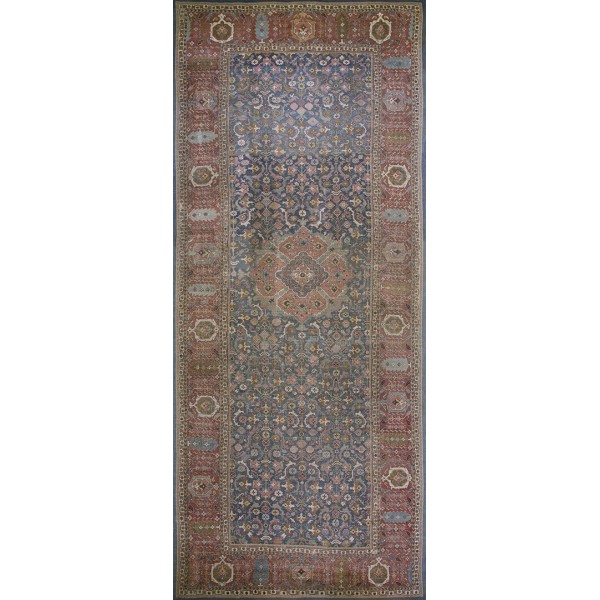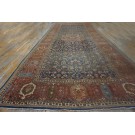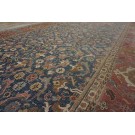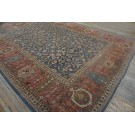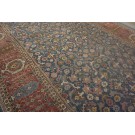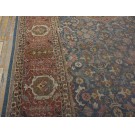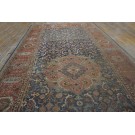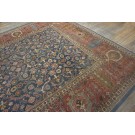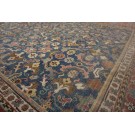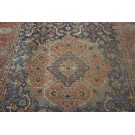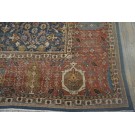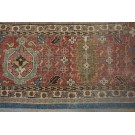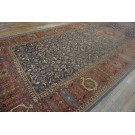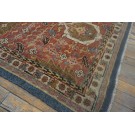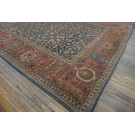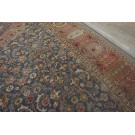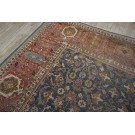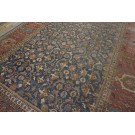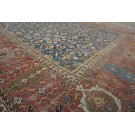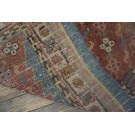Early 18th Century South Caucasian Carpet
#24434
Caucasian or Northwest Persian Long Carpet
Southern Caucasus or Persian Azerbaijan Border Area
Early 18th century
Warp: rewarped overall in modern white cotton
Weft: double wefted in wool; with marker wefts every 1” to2”
Pile: wool, Z-2 handspun
Knots: horizontally 12 average x vertically 10 average, average 120 knots/ square inch
Sides: reovercast, not original
Ends: not original
With a strong, resilient pile, this large kellegi carpet. has been carefully restored fully in the original character. The field abrashes from darkish blue to a teal blue, while displaying an allover pattern of sickle leaves, pomegranates, rosettes and small palmettes. The pattern passes beneath the rounded, ogival medallion. The medallion was “plopped” onto the field and has no connexion with it. This became the common practice in the 18th century when the field patterns and the medallions became independent of each other. A medallion could be set on any field and any medallion could work on a given field. The medallion is more Persianate than the contemporaneous Caucasian “Sunburst” medallions. The main terra cotta strip style border features reversing turtle palmettes and cypress trees. The borders are loosely balanced internally at their ends, but there is no flow around the corners. A related border design may be found on 18th century Indo-Isfahan carpets, although there is no likelihood of copying. The wool is similar to the bristly, firm, resilient pile on Dragon and Blossom Caucasians of the period. The marker wefts are placed regularly, with about 30,000 knots between, the average work of four or five weavers per day. Thus, the rug took about 180 to 200 days to weave. This is comparable to the rate observed in recent village pieces. The carpet was woven, as is the general practice in the area, on a vertical loom, probably a version of the Tabriz warp slide around loom, half as high as the rug is long. It was a professional, workshop creation. Marker wefts in Caucasian pieces are more widely and more erratically placed than on this rug. The marker wefts delimit one day’s work.
The field pattern has been observed on other Persianate pieces of the period, but does not seem to have evolved into the Herati or other common Persian allover designs. It seems to have passed out of use in the 19th century. It does not have a common name. The even allover wear is consistent with the European practice of rotating the carpets, while many American pieces are dished out because they are not rotated to even out the wear. There has been very slight reduction at the lower end, but the condition is good for the period. The palette is softer, but not muted. All dyes are natural, and are professionally dyed, with the indigo-based blues from a specialist. This is a town carpet and the weavers have no part in the dyeing process, unlike village and tribal artisans.
A more specific attribution to a Caucasian or Persian atelier is not possible at this time, so assigning it to either area is possible.
Provenance: from a Scottish estate.
Caucasian or Northwest Persian Long Carpet
Southern Caucasus or Persian Azerbaijan Border Area
Early 18th century
Warp: rewarped overall in modern white cotton
Weft: double wefted in wool; with marker wefts every 1” to2”
Pile: wool, Z-2 handspun
Knots: horizontally 12 average x vertically 10 average, average 120 knots/ square inch
Sides: reovercast, not original
Ends: not original
With a strong, resilient pile, this large kellegi carpet. has been carefully restored fully in the original character. The field abrashes from darkish blue to a teal blue, while displaying an allover pattern of sickle leaves, pomegranates, rosettes and small palmettes. The pattern passes beneath the rounded, ogival medallion. The medallion was “plopped” onto the field and has no connexion with it. This became the common practice in the 18th century when the field patterns and the medallions became independent of each other. A medallion could be set on any field and any medallion could work on a given field. The medallion is more Persianate than the contemporaneous Caucasian “Sunburst” medallions. The main terra cotta strip style border features reversing turtle palmettes and cypress trees. The borders are loosely balanced internally at their ends, but there is no flow around the corners. A related border design may be found on 18th century Indo-Isfahan carpets, although there is no likelihood of copying. The wool is similar to the bristly, firm, resilient pile on Dragon and Blossom Caucasians of the period. The marker wefts are placed regularly, with about 30,000 knots between, the average work of four or five weavers per day. Thus, the rug took about 180 to 200 days to weave. This is comparable to the rate observed in recent village pieces. The carpet was woven, as is the general practice in the area, on a vertical loom, probably a version of the Tabriz warp slide around loom, half as high as the rug is long. It was a professional, workshop creation. Marker wefts in Caucasian pieces are more widely and more erratically placed than on this rug. The marker wefts delimit one day’s work.
The field pattern has been observed on other Persianate pieces of the period, but does not seem to have evolved into the Herati or other common Persian allover designs. It seems to have passed out of use in the 19th century. It does not have a common name. The even allover wear is consistent with the European practice of rotating the carpets, while many American pieces are dished out because they are not rotated to even out the wear. There has been very slight reduction at the lower end, but the condition is good for the period. The palette is softer, but not muted. All dyes are natural, and are professionally dyed, with the indigo-based blues from a specialist. This is a town carpet and the weavers have no part in the dyeing process, unlike village and tribal artisans.
A more specific attribution to a Caucasian or Persian atelier is not possible at this time, so assigning it to either area is possible.
Provenance: from a Scottish estate.
| Stock ID: | #24434 |
| General Rug Type: | Caucasian |
| Specific Rug Type: | Caucasian |
| Circa: | 1720 |
| Ground Color: | Blue |
| Border Color: | Red Rust |
| Origin: | Caucasus |
| Material: | Wool |
| Weave: | Pile - Knotted |
| Shape: | Rectangle |
| Width: | 9' 3" ( 282 cm ) |
| Length: | 21' 10" ( 665 cm ) |
| Tearsheet Download |
